Biology
Biology concepts ? taste sensation, non-lingual taste receptors, solitary chemoreceptor cells
In our recent discussions of the gustatory sense (here, here, and here), we have highlighted the idea that taste is basically a nutrient/poison detection system. You can avoid toxins (sour, bitter) or find nutrients (salty, sweet, umami, fat) of based just on taste. In terms of avoiding toxins; you taste it, and hopefully don?t swallow enough to be harmful to you.
The GI system happens to have many taste receptors; the stomach, small bowel, and large bowel (colon) of mammals have receptors for sweet, fat, bitter, and umami. Interesting that these are the receptors for nutrients and toxins. If you happen to swallow a bitter toxin, the gut receptors stimulate an ion release into the gut.
CCK also stimulates the release of bile from the gall bladder to aid in the digestion of fats. Fats and amino acids go hand in hand, since meat contains much of both. This may account for the presence of fat taste receptors (CD36 and GPR120) in the gut as well. Fat is harder to digest that other nutrients, so CCK stimulates a slowing of the bowel and a longer retention time in the stomach and gut.
There are even taste receptors for sugars in your brain. The hypothalamus is a part of your brain ? an important part - O.K. so all the parts are important. But it seems that blood glucose sensing is particularly acute in the hypothalamus. This is a little harder than it would seem at first thought. You have to sense the glucose levels without being thrown off by sensing the levels of glucose being metabolized in the cell itself. Since cells manage their internal glucose levels, any monitoring system based on this would always report the same result.
Perhaps sensing bitter compounds in the brain fluid results in a further clamping down on what molecules can get into the brain by manipulating the BBB. The 2012 paper only speculated that the receptors might have other, non-gustatory functions. We have seen above how taste receptors help sense nutrient levels, so it is plausible that bitter receptors in the brain could be sampling for toxins, and then induce some protective response. I bet that's being studied as we speak.
Sundaresan S, Shahid R, Riehl TE, Chandra R, Nassir F, Stenson WF, Liddle RA, & Abumrad NA (2013). CD36-dependent signaling mediates fatty acid-induced gut release of secretin and cholecystokinin. FASEB journal : official publication of the Federation of American Societies for Experimental Biology, 27 (3), 1191-202 PMID: 23233532
Kyriazis GA, Soundarapandian MM, & Tyrberg B (2012). Sweet taste receptor signaling in beta cells mediates fructose-induced potentiation of glucose-stimulated insulin secretion. Proceedings of the National Academy of Sciences of the United States of America, 109 (8) PMID: 22315413
Wauson EM, Zaganjor E, Lee AY, Guerra ML, Ghosh AB, Bookout AL, Chambers CP, Jivan A, McGlynn K, Hutchison MR, Deberardinis RJ, Cobb MH. (2012). The G protein-coupled taste receptor T1R1/T1R3 regulates mTORC1 and autophagy. Mol Cell., 47 (6), 851-862 DOI: 10.1016/j.molcel.2012.08.001
Dehkordi O, Rose JE, Fatemi M, Allard JS, Balan KV, Young JK, Fatima S, Millis RM, & Jayam-Trouth A (2012). Neuronal expression of bitter taste receptors and downstream signaling molecules in the rat brainstem. Brain research, 1475, 1-10 PMID: 22836012
- #113 The Control Of Blood Glucose
The blood glucose concentration is regulated by negative feedback control mechanisms. Blood glucose concentration should remain at a fairly constant value of about 100 mg glucose per 100 cm3 of blood. If blood glucose concentration falls well below...
- #112 Osmoregulation
Osmoregulation is the control of the water content of body fluids. It is part of homeostasis, the maintenance of a constant internal environment. It is important that cells are surrounded by tissue fluid of a similar water potential to their own...
- Proteins
PROTEINSProteins are polypeptides. i.e., linear chains of amino acids linked by peptide bonds. A Peptide bond is formed when ?COOH group of one amino acid reacts with ?NH2 group of next amino acid by releasing a molecule of water (dehydration). Proteins...
- Cats Don?t Taste Sweet, But Dogs Taste Salty
Biology concepts ? gustatory sense, taste receptors, supertasters We have discussed recently the reasons organisms taste their food are related to nutritional needs (sweet, umami, salt, fat) and protection from toxins (sour, bitter). Sweet is the exceptional...
- Sweet, Salt, Bitter, Sour - They Ain't The Half Of It
Biology concepts ? umami, taste, flavor, gustation, glutamate, chemoreception, CD36, fat taste, water receptor, calcium Perhaps I was a little hasty when I said umami wasn?t the name of a new band. Apparently ?Umami? is the name of a band from Minneapolis....
Biology
Tasting With Every Part Of Your Body
Biology concepts ? taste sensation, non-lingual taste receptors, solitary chemoreceptor cells
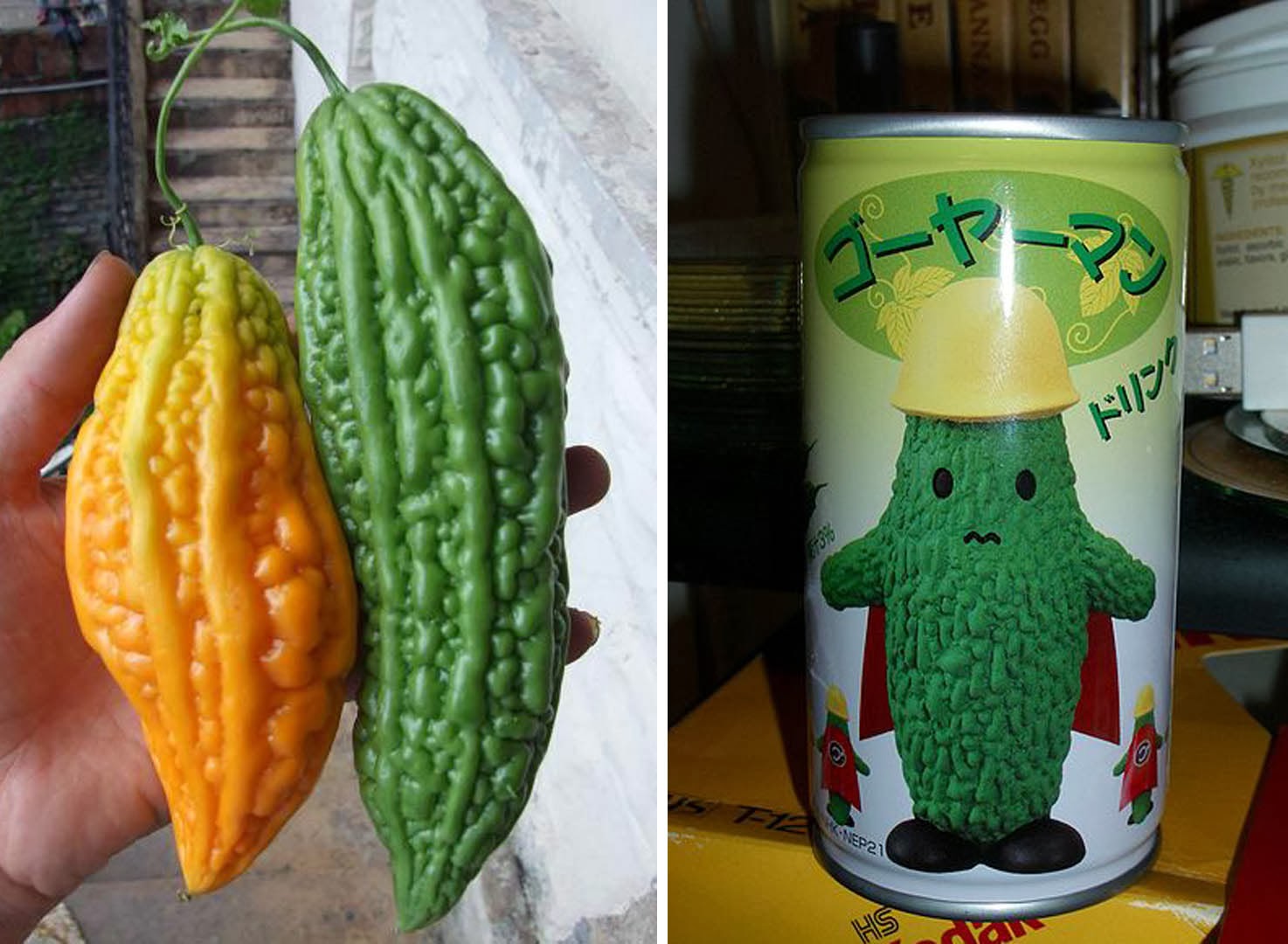 |
| Bitter melon (Momordica charantia) goes by many names, like goya, kalera, etc. It is native to the subcontinent and Asia, and is used in many cuisines. I have not tried it, but I have heard it described as tasting like evil, or a cross between uncooked collard greens and chewing on aspirin. Despite this, there is a bittermelon soda sold in Japan. My point ? even though bitter is supposed to warn of poison, people can learn to love it. Are they more likely to be poisoned? |
A question occurs to me in this scenario ? why not taste things somewhere other than the opening of your gastrointestinal (GI) system? You would be much less likely to ingest a toxin if you never put it in your mouth. Tasting something with the ends of your fingers, for example, would identify sour and bitter ? things to toss toward your enemy, and could identify cupcakes and filet mignon as well. Everything would be finger food.
Yet there they are, all those taste buds sitting on our tongue, the inviting front porch swing to our GI tract. Frogs, civet cats, owls ? vertebrates of all types have oral taste buds. But it gets weird if you want to start counting all of them, because they aren?t all on your tongue. There are taste buds on your palate (roof of your mouth) and in your throat, and these are just the taste buds. It gets weirder - animals have taste cells and taste receptors in some really weird places.
We have discussed, and will discuss again, how closely related are smell and taste, how they work on a molecular level and how the senses work together to form a flavor. We know now that mammals have taste receptors in their noses!
Bitter taste receptor cells are scattered throughout the nasal cavity, not grouped together in taste buds, so they are called solitary chemoreceptor cells. Maybe this is a way to detect bitter and possibly toxic stimuli before you put them in your mouth - our idea of evolving protective taste sense outside the GI tract may not be some dumb after all. However, the original paper saw that they were linked to increasing respiration rate (to get toxic substances out of the lungs faster).
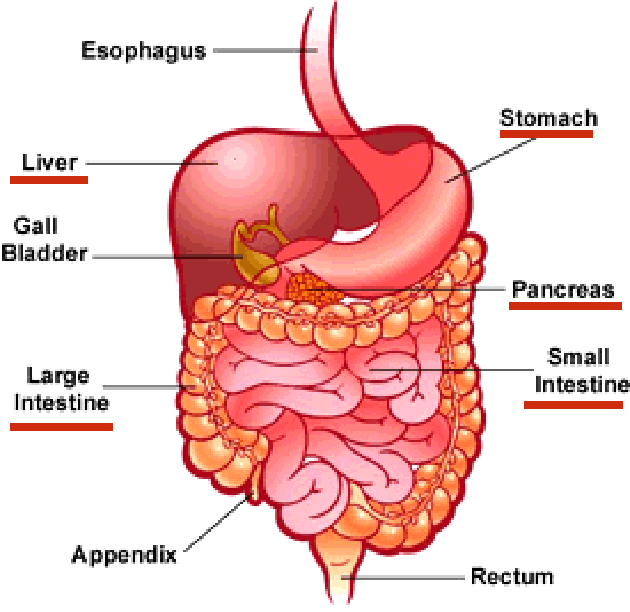 |
| Here is most of your gastrointestinal tract. The elements underlined in red have been shown to express taste receptors. They may acts as nutrient sensors, as hunger modulators, or even protection against poisoning. To understand what those mean ? read the post! Those not underlined most likely express the receptors too, they just haven?t been studied for that yet. |
Water follows the ions due to osmotic pressure, and this would help to flush the toxin through the system faster (ie. diarrhea). This makes sense, but I don?t know if it plays out that way in real life. Not everybody gets to spend hours in the bathroom after eating something bitter - there are probably other issues in play.
On a sweeter note, it has been shown that many intestinal cells express functional sweet heterodimer receptors (T1R2 + T1R3). Cells call enteroendocrine cells (entero = gut, endo = within, and crine= distinguish) produce many of these receptors, and act as sensors for sugar in the gut.
When the enteroendocrine cells detect sugar or artificial sweeteners, they produce hormones that stimulate other gut cells to make more glucose transporters. This is another way that your body works hard to make sure you get all the carbohydrate you can for energy production ? it never wants a carbohydrate to get through the gut without being snatched up for use.
Umami receptors are also found in the gut, including the enteroendocrine cells. It was shown in 2013 (here and here) that amino acids are sensed by these receptors, and stimulate release of a hormone called cholecystokinin (CCK), which works in part to tell your brain you that are full.
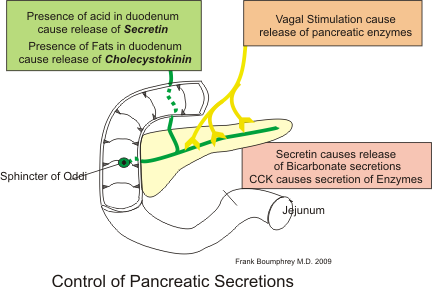 |
| Cholecystokinin (CCK) is a multifunctional hormone released from the small intestine after consuming proteins or fats. It is a hunger suppressant; appetite is controlled by the hypothalamus of the brain. It can?t cross the blood brain barrier (BBB), but the hypothalamus isn?t protected by the BBB. Interesting, no? It just happens that CCK is inhibited by capsaicin, so maybe it isn?t a good idea to eat spicy and fatty foods in the same sitting. |
Outside the gut, your GI system also expresses taste receptors in the pancreas. You are constantly sensing how much sugar is your blood, and how much is coming in via your gut absorption. Your pancreas has beta cells that produce insulin to increase the amount of sugar taken up by your cells; this reduces your blood sugar levels.
There are multiple mechanisms by which your pancreas knows to make or release more insulin. Chewing, blood glucose levels, stress levels, exercise, and other signals control the balance between hormone signals that reduce (insulin) or increase (glucagon) blood glucose levels. Now these mechanisms must include sweet receptors on the beta cells.
A 2009 paper showed that functional sweet taste receptors were located on the beta cells in mouse pancreas, they have also been found now in humans. Activation of these receptors by sugars or artificial sweeteners stimulate the beta cells to release insulin and lower blood sugar levels. A more recent study indicates that fructose is also sensed by sweet receptors on beta cells and can amplify insulin signals triggered by binding glucose. This is just more evidence that postprandial (after a meal) nutrient sensing in the pancreas is mediated, at least in part, through taste receptors.
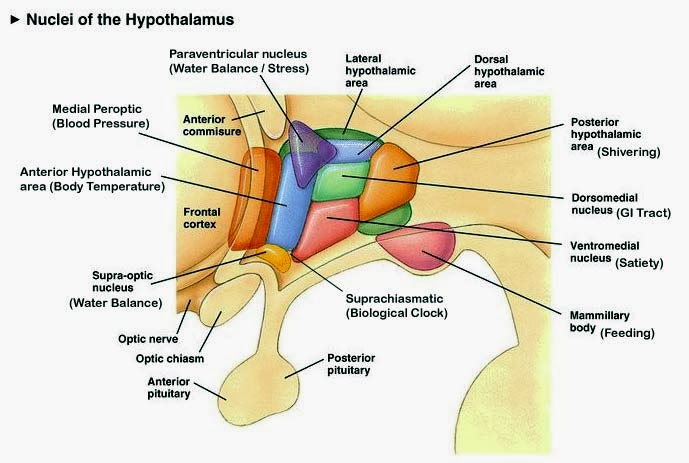 |
| The hypothalamus works in several systems, including appetite. Interestingly, different parts of the hypothalamus are in charge of satiety (being full) and the want of feeding. Water is a whole other matter. All together, the different nuclei manage the basic control systems of the body, food water, temperature, blood pressure, etc. |
But the hypothalamus expresses sweet receptors on the outside of its neurons. Even more, the numbers of receptors is influenced by the nutrient state of the animal. More glucose sensed in other parts of the body (like the taste receptors of the gut), will result in reduced expression in the hypothalamus. This relates to the function of the hypothalamus in appetite as well. More receptor activity relative to the number of receptors, the more signals will be sent out that you are full.
There are more even brain areas that express taste receptors. A 2012 study shows that the rat brainstem has bitter receptors to sample the extracellular fluids for bitter compounds. This may be to try and act as a late protector of the brain against toxins. We have talked before about how the blood brain barrier is designed to protect the brain from toxins better than the blood vessels of the rest of the body.
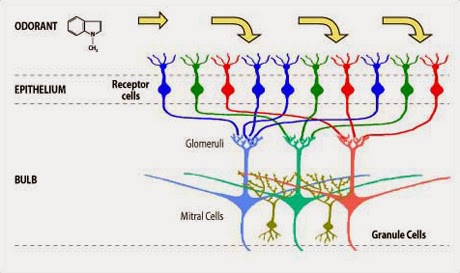 |
| Taste receptors in the brain (brainstem, hypothalamus, etc) are attached to neurons, not epithelial cells. It?s the brain, for gosh sakes, there?s nothing but neurons. This makes the system more like smell than taste. No taste cells; the signal is directly transduced to an action potential. |
Lastly, recent evidence may show that monitoring taste receptor expression in different tissues may be moot. It may be that every cell in your body has taste receptors! It may be that the T1R1+T1R3 amino acid taste receptor is in/on every cell sensing whether it has enough free amino acids available.
Amino acid availability is crucial for cellular function. Your cells are producing new proteins all the time, to replace old proteins and to make different proteins that would respond to changes in cell condition and environment. Without a constant source of amino acid building blocks, each cell has to seek out an amino acid supplier. Autophagy(auto = self, phagy = eat) is the answer in most cases.
In times of low amino acid stores, a 2012 study indicates that decreased signaling through the umami taste receptors on your cells will trigger a cascade of responses and the cells start to digest themselves (autophagy). They will break down organelles and proteins so that the amino acids can be recycled for proteins of immediate need. As you can guess, this isn?t the best way to run a business, robbing Peter to pay Paul, so autophagy beyond the normal (getting rid of unneeded or old structures) will have consequences. Muscle wasting in starved individuals is often a result of autophagy.
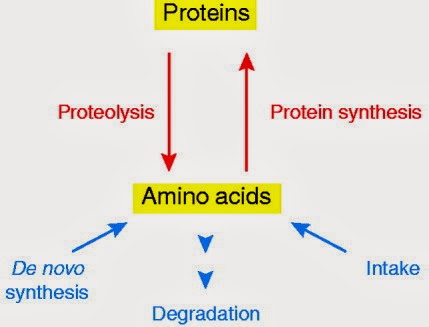 |
| Every cell has to have a source of free amino acids. There is a balance that must be maintained. On the bottom right, ?intake? represents the eating of protein. If that doesn?t occur, then amino acids must be made from building blocks (bottom left). If there is intake, then new proteins can be made (synthesis). But if there is no intake, and little de novo synthesis, then proteolysis (a form of autophagy) will result in free amino acids for protein synthesis. |
A 2005 paperhypothesized (now proven) that all these extraoral taste receptors on solitary chemosensory cells form a diffuse chemosensory system. The taste buds are just the most visible part of a much larger, more complex system of taste. The big picture ? organisms taste themselves to monitor their nutrition and health. This isn?t really an exception, just a huge misconception.
So nature evolved extraoral taste receptors for mammals. Why didn?t it take the next step and get rid of oral taste buds? Come back in a million years and maybe we?ll be tasting with our elbows. Sounds ridiculous, doesn?t it. Well, not so fast. Next week we will see that some organisms taste things with some very peculiar body parts.
For more information, see:
Extra-oral taste perception ? Most of this information is recent enough that scientific journal articles are the only source of information. Follow the links in the post and those below.
http://www.sciencedirect.com/science/article/pii/S1084952112001462
http://www.sciencedaily.com/releases/2007/08/070820175426.htm
http://www.adelaide.edu.au/news/news64082.html
http://consumer.healthday.com/diabetes-information-10/diet-diabetes-news-178/pancreas-may-taste-fructose-hinting-at-links-to-diabetes-661517.html
http://www.physoc.org/proceedings/abstract/Proc%20Physiol%20Soc%2016PC35
http://www.sciencedirect.com/science/article/pii/S0006291X11001999
- #113 The Control Of Blood Glucose
The blood glucose concentration is regulated by negative feedback control mechanisms. Blood glucose concentration should remain at a fairly constant value of about 100 mg glucose per 100 cm3 of blood. If blood glucose concentration falls well below...
- #112 Osmoregulation
Osmoregulation is the control of the water content of body fluids. It is part of homeostasis, the maintenance of a constant internal environment. It is important that cells are surrounded by tissue fluid of a similar water potential to their own...
- Proteins
PROTEINSProteins are polypeptides. i.e., linear chains of amino acids linked by peptide bonds. A Peptide bond is formed when ?COOH group of one amino acid reacts with ?NH2 group of next amino acid by releasing a molecule of water (dehydration). Proteins...
- Cats Don?t Taste Sweet, But Dogs Taste Salty
Biology concepts ? gustatory sense, taste receptors, supertasters We have discussed recently the reasons organisms taste their food are related to nutritional needs (sweet, umami, salt, fat) and protection from toxins (sour, bitter). Sweet is the exceptional...
- Sweet, Salt, Bitter, Sour - They Ain't The Half Of It
Biology concepts ? umami, taste, flavor, gustation, glutamate, chemoreception, CD36, fat taste, water receptor, calcium Perhaps I was a little hasty when I said umami wasn?t the name of a new band. Apparently ?Umami? is the name of a band from Minneapolis....
